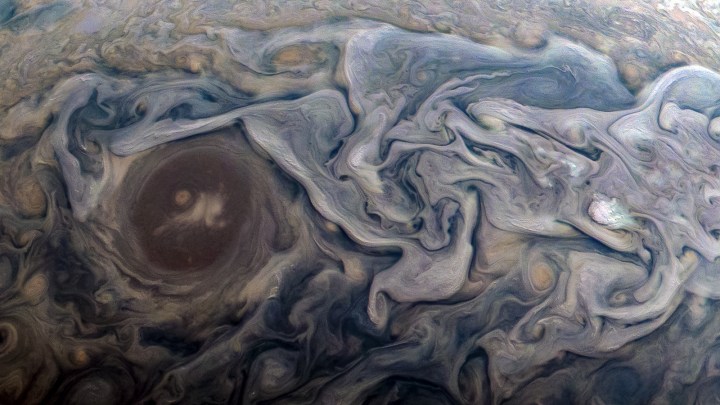
NASA’s Juno spacecraft has captured this gorgeous image of Jupiter during its 18th flyby of the planet. This new perspective shows dramatic circling cloud formations which swirl around a jet stream known as Jet N6. The spot is an example of a high-pressure region in the atmosphere which is believed to be a storm which could continue to rage for hundreds of years.
The image wasn’t created by a professional astronomer, but rather by citizen scientist Kevin M. Gill who used data from the craft’s JunoCam imager to put together this new view of the planet. The JunoCam’s raw images are made available for the public to look at and to process into images on the JunoCam website, so if you fancy making some Jupiter images of your own, you can.
The Juno spacecraft was launched in August 2011 aboard an Atlas V 551 rocket, taking two years to travel through the solar system before performing a close Earth flyby in October 2013. It used Earth’s gravity to slingshot towards Jupiter at a high speed, eventually arriving at the planet in July 2016. Getting the craft to its destination was challenging, but getting it into orbit was even more difficult as it had to perform a maneuver called Jupiter Orbit Insertion in which it fired its main engine for about 30 minutes to slow it down enough to enter the planet’s orbit.
The maneuver worked successfully and the craft completed its first flyby of the planet in August 2016. Since then it has been gathering data on Jupiter’s gravity and magnetic fields to learn more about the interior structure of the planet. There is much we still don’t know about Jupiter as the clouds and massive storms in the atmosphere block views of the surface, so Juno uses observations of the atmosphere and magnetosphere to gather data on questions like whether the planet has a solid core and how it generates its large magnetic field.
The JunoCam is just one of the nine instruments on board the Juno craft, though it is unusual as its primary purpose is to gather images for education and public outreach rather than for scientific purposes. By this metric it has been a great success, producing a series of stunning images like the one above which have captured the imagination of space enthusiasts around the world.



